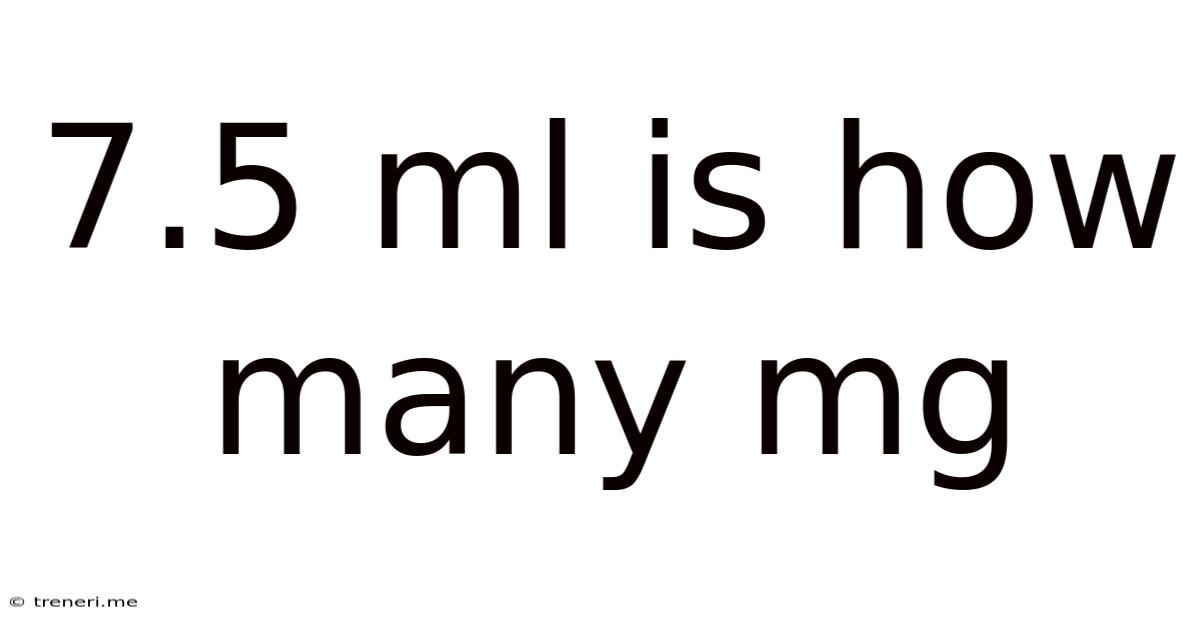7.5 Ml Is How Many Mg
Treneri
Apr 07, 2025 · 4 min read

Table of Contents
It's impossible to definitively answer "7.5 ml is how many mg?" without knowing the density of the substance being measured. Milliliters (ml) is a unit of volume, while milligrams (mg) is a unit of mass (or weight). To convert between the two, you need the density, which relates volume to mass. The density is typically expressed in mg/ml (milligrams per milliliter) or g/ml (grams per milliliter).
This article will explore the relationship between milliliters and milligrams, explain why a direct conversion isn't possible without additional information, and provide examples illustrating how to perform the conversion with known densities. We'll also delve into common misconceptions and offer practical applications to enhance your understanding.
Understanding the Difference: Volume vs. Mass
Before we proceed, it's crucial to understand the fundamental difference between volume and mass.
-
Volume: Volume refers to the amount of three-dimensional space occupied by a substance. Milliliters (ml) is a common unit of volume, often used for liquids.
-
Mass: Mass refers to the amount of matter in a substance. Milligrams (mg) is a unit of mass, indicating the weight of an object.
Think of it this way: you could have 7.5 ml of water, and 7.5 ml of honey. Both occupy the same volume, but honey is much denser than water, meaning it has a significantly greater mass (and therefore weight) in the same volume.
The Crucial Role of Density
Density is the key to converting between volume and mass. It's defined as the mass per unit volume:
Density = Mass / Volume
This means:
Mass = Density × Volume
And:
Volume = Mass / Density
To convert 7.5 ml to mg, we need the density of the substance expressed in mg/ml. Let's explore some examples.
Example Conversions: Different Substances, Different Densities
Let's illustrate the conversion with a few common substances:
1. Water:
The density of water is approximately 1 g/ml, which is equivalent to 1000 mg/ml. Therefore, if we have 7.5 ml of water:
Mass = Density × Volume = 1000 mg/ml × 7.5 ml = 7500 mg
Therefore, 7.5 ml of water is approximately 7500 mg.
2. Mercury:
Mercury is significantly denser than water. Its density is approximately 13.5 g/ml, which is equivalent to 13500 mg/ml. For 7.5 ml of mercury:
Mass = Density × Volume = 13500 mg/ml × 7.5 ml = 101250 mg
Therefore, 7.5 ml of mercury is approximately 101250 mg.
3. Olive Oil:
Olive oil has a density of roughly 0.92 g/ml, or 920 mg/ml. For 7.5 ml of olive oil:
Mass = Density × Volume = 920 mg/ml × 7.5 ml = 6900 mg
Therefore, 7.5 ml of olive oil is approximately 6900 mg.
These examples clearly demonstrate that the mass (in mg) corresponding to a given volume (in ml) varies drastically depending on the substance's density.
Common Misconceptions and Pitfalls
It's vital to avoid common mistakes when dealing with volume and mass conversions:
-
Assuming a universal density: Do not assume that all substances have the same density. This is a critical error leading to inaccurate calculations. Always refer to a reliable source for the density of the specific substance.
-
Incorrect unit conversions: Ensure you're using consistent units throughout your calculations. For example, if the density is given in g/ml, you need to convert it to mg/ml before multiplying by the volume in ml.
-
Neglecting significant figures: When reporting your final answer, pay attention to significant figures to reflect the precision of your measurements and calculations.
Practical Applications: Where This Conversion is Important
Understanding the relationship between milliliters and milligrams is crucial in various fields:
-
Pharmacy and Medicine: Accurate dosage calculations often require converting between volume (ml) and mass (mg), particularly when dealing with liquid medications.
-
Chemistry and Chemical Engineering: Many chemical reactions and processes involve precise measurements of both volume and mass.
-
Food Science and Nutrition: Determining the nutritional content of food often involves considering both volume and mass.
-
Environmental Science: Measuring pollutants in water or air samples frequently involves converting between volume and mass.
Beyond the Basics: Advanced Considerations
While the examples above provide a basic understanding, there are more nuanced aspects to consider:
-
Temperature Dependence: Density can vary slightly with temperature. For highly accurate calculations, consider the temperature at which the measurement was taken and use the corresponding density value.
-
Pressure Dependence: For gases, pressure also significantly affects density. High pressure will result in higher density.
-
Non-homogeneous Substances: The density of a non-homogeneous mixture might not be uniform throughout the sample. In such cases, more complex methods are needed to determine the average density.
Conclusion: The Importance of Context
In conclusion, the question "7.5 ml is how many mg?" cannot be answered without knowing the density of the substance in question. The relationship between volume and mass is fundamental in many scientific and practical applications, making it crucial to understand the concept of density and its role in accurate conversions. Remember to always double-check your units, consider potential sources of error, and consult reliable sources for density values to ensure accurate results. Understanding these principles will enable you to confidently perform these conversions in various contexts.
Latest Posts
Latest Posts
-
Como Calcular Horas Extras Dobles Y Triples
May 09, 2025
-
Cuantos Dias Son Del 14 De Febrero A Hoy
May 09, 2025
-
What Is The Gcf Of 72 And 18
May 09, 2025
-
60 Days From September 18 2024
May 09, 2025
-
How Do You Figure Out Prorated Rent
May 09, 2025
Related Post
Thank you for visiting our website which covers about 7.5 Ml Is How Many Mg . We hope the information provided has been useful to you. Feel free to contact us if you have any questions or need further assistance. See you next time and don't miss to bookmark.